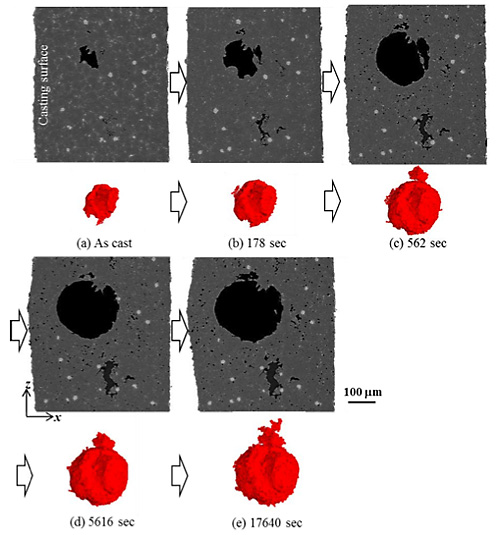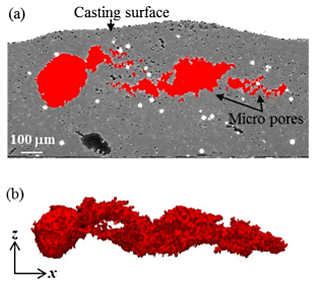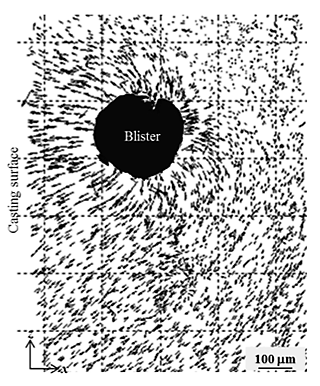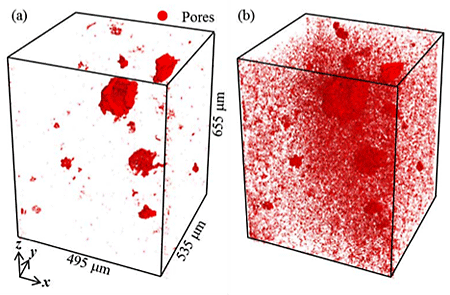1. Introduction
It has been well documented that the blister formation mechansm is air entrapment during casting and/or precipitation of dissolved gas from a solid metal. The former has been typically reported in the case of die casting, in which high-speed turbulent fluid is generated in the die casting sleeve, thereby causing gas in the sleeve to become entrapped in the molten metal. The objective of the present study is to investigate the nucleation and growth mechanisms of a cast aluminium alloy blister during high temperature exposure, using state-of-the-art synchrotron X-ray microtomography.
2. Experimental procedures
The material used was an Al-Si-Cu die cast aluminium alloy of a chemical composition range of 9.6 to 12.0 Si, 1.5 to 3.5 Cu, < 1.3 Fe, < 1.0 Zn, < 0.3 Mn, < 0.3 Mg, < 0.3 Ti, < 0.2 Pb, < 0.2 Sn and balance Al in mass %. A rectangular cylinder specimen, 0.6 ![]() 0.6 mm in cross-section and 10 mm in length, was sampled from a die-cast automotive component cast in air, so that the casting surface was preserved as one of the four specimen side surfaces.
0.6 mm in cross-section and 10 mm in length, was sampled from a die-cast automotive component cast in air, so that the casting surface was preserved as one of the four specimen side surfaces.
A high-resolution projection-type microtomography experiment was performed using the undulator beamline BL47XU of the SPring-8 facility. The size of an isotropic voxel in the reconstructed slices was 0.503 µm by which spatial resolution of about 1 µm is realized.
3. Results
The blister nucleus and its change during the high-temperature exposure are shown in Fig. 1. Extracted 3D blister nucleus images are shown in Fig. 1, together with their corresponding two-dimensional images on identical virtual cross-sections.
Surface elevation was also observed after the thermal exposure time of 5616 sec, and the blister formation was macroscopically observable at the stage shown in Fig. 2. The flow of the matrix material has been rendered in 3D, in Fig. 3, by tracking particles between 5616 and 17640 sec. The vectors represent the displacement of individual particles, projected onto the x-z plane. Extensive deformation toward the casting surface is observed, together with expansion of the largest pore, which spreads across a wide area of about 5 times the largest pore size parallel to, and 3 times the largest pore size perpendicular to, the casting surface.
Considerable micro pore formation is confirmed in Fig. 4, in which all the pores observed in the field of view are rendered. Since hydrogen is the only gas with measurable solubility in aluminium and its alloys, it is reasonable to assume that such micro pores are filled with hydrogen. It has been confirmed that the growth behaviour of such hydrogen micro pores at high temperatures is dominated by Ostwald ripening. The corresponding continuous growth of relatively coarse pores and annihilation of fine micro pores is observed in Fig. 4, in which the underlying aluminium matrix and second-phase particles are not displayed. Notably, a pore-depleted band is observed around the blister nucleus, as is clearly shown in the virtual cross-sections captured at 5616 and 17640 sec, and it is interesting to note that the width of the pore-depleted band corresponds well to that of the large strain band. It may therefore be inferred that micro pore formation was disturbed due to the existence of the compressive strain caused by the radial expansion of the blister nucleus.
4. Conclusion
Initiation and growth of a blister in a die cast aluminium alloy were observed in-situ using the synchrotron X-ray microtomography technique. It has been revealed that gases entrapped during die casting, such as nitrogen and carbon dioxide, fill the blister nucleus. Remarkably high internal gas pressure leads to the expansion of the blister nucleus due to the creep deformation of the surrounding aluminium matrix. Hydrogen precipitation and micro pore growth occur at the same time as the growth of the blister nucleus, resulting in further expansion of the blister nucleus through its absorption of surrounding hydrogen micro pores and pre-existing pores.



